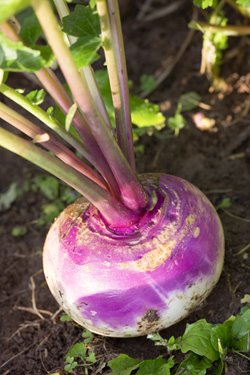Turnips are a root vegetable every gardener should grow. They can be used in plenty of
recipes, offer tons of
health benefits and are easy to grow from scratch.

There are several varieties grown in the UK, so you can choose the one that entices you the most. Popular varieties include:
- Purple Top Milan – This fast-growing, early variety with white roots and purple tops is known for its punchy flavour.
- Green Globe – A maincrop option with white, round roots, this variety is commonly used for turnip tops (leaves).
- Oasis – Ready to eat raw or can be cooked, this summer variety with virus-resistant roots is a Japanese turnip type with a sweet and fruity flavour.
- Atlantic – These turnips can be harvested young, making them a great choice for growing in a container. Its purple top is a defining characteristic and it has a succulent, sweet taste.
Whichever you choose, your next growing project is sure to be tasty. Just use our guide below to sow, plant and harvest your turnips at the right time and learn how to care for them.
When to sow and grow turnips
Turnips are grown and harvested throughout the year. Typically, you'll sow them between February and August, and they can be harvested between March and December.
How to grow turnips
Start by getting your turnip seeds from a reputable online supplier or local garden centre, and follow these steps:
1. Prepare the planting ground
Dig in well-rotted manure and remove weeds in the area. Try to do this in autumn before you sow in late winter onwards.
2. Sowing and planting your seeds outdoors
The sowing season is from March to August, although sowings of early varieties can be made in February under cloches or in polytunnels. Choose maincrop varieties for sowing in July and August.
Sow the seeds directly into the ground by picking a sunny spot and making a shallow drill, 1cm deep. Scatter seeds along the drill, cover with soil, firm gently and water lightly. Space your drills out in rows 23-30cm apart for early crops and 30cm apart for maincrops.
Alternatively, sow them in containers if you're lacking ground space. Pick a container that's at least 40cm wide and fill with multi-purpose compost and water. Scatter your seeds along the top and cover with 2cm of compost.
Sowing turnips indoors
Sow inside during winter months for an early harvest. Just follow these steps:
- Fill modular trays with seed compost and water well.
- Create a 2cm hole in every module and put two seeds in. Cover and once germinated, remove the weaker seed.
- Harden them off in early March to help them acclimatise to the outdoors.
- Plant them in the prepared ground, leaving 15-23cm of space between them.
Caring for turnips while they grow
Turnips love water, so give them plenty while they grow. This is especially important through hotter, drier months as dehydration can lead to roots becoming small and woody or splitting.
Weeding is another important job as weeds can steal light, water and nutrients from your turnips. Remove weeds close to the plants by hand to ensure you don't accidentally harm the root top with a tool.
Slugs and snails are sometimes a problem during wet months but can be removed by hand or with slug pellets. Birds can be an issue too so invest in
netting or a
cloche to cover turnips and deter them.
How long do turnips take to grow and when should I harvest them?
Turnips grow quickly and can be harvested from week six to 10 depending on the variety. You'll know your turnips are ready to harvest when they're the size of a golf ball or a tennis ball if you're using them for cooking.
To harvest, simply dig around them, pull them out of the ground, wash off the soil and they'll be ready to use. The leaves can be harvested too and are great for salads or cooked.
Turnips can be stored for use at a later date. Just wrap them in a moist cloth and store them in your fridge. Longer term, store them in your freezer where they should keep for several months.
Benefits of growing turnips in a polytunnel
You can grow the best turnips in a polytunnel because of the following benefits:
- Shelter from rain and snow to prevent disease and rot
- Protection from strong winds which can cause crop damage
- Protection from pests and birds
- An optimal climate for crop growing
Get a polytunnel to make growing turnips easier
If turnips seem like your ideal growing project, boost your chances of a delicious crop with a polytunnel. We have
plenty of sizes available to fit your garden or allotment space. What's more, we stock
cloches,
polytunnel replacement covers and other
accessories.
Got a question about our polytunnels? Get in touch by calling
01282 811250,
requesting a call back or emailing us at
info@premierpolytunnels.co.uk.
For any other gardening inspiration, check out our
growing guides for more crops to add to your collection.